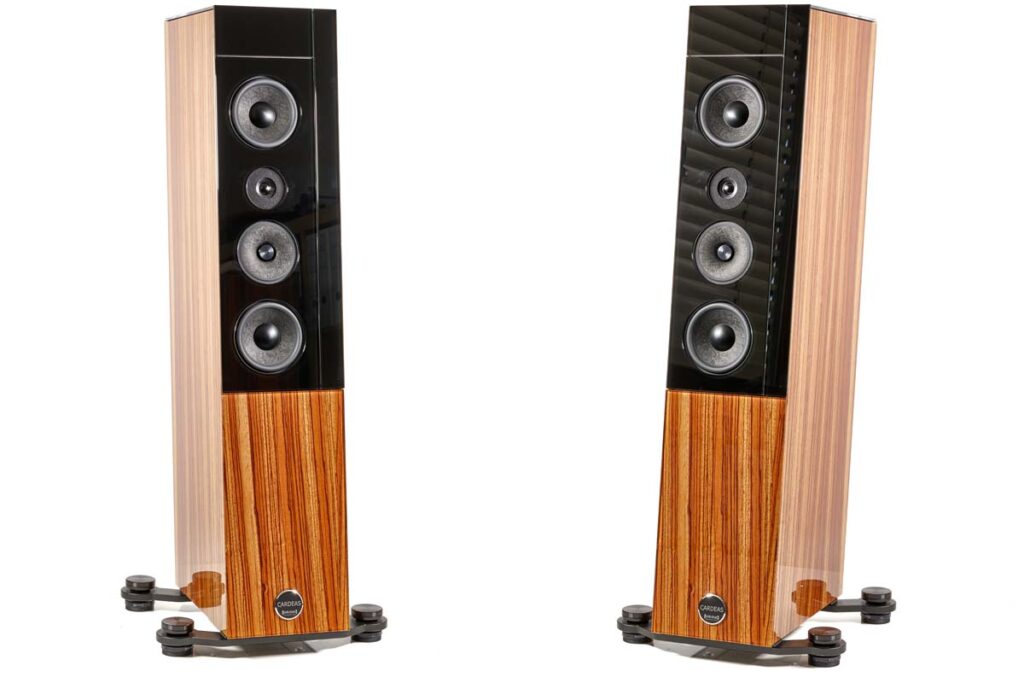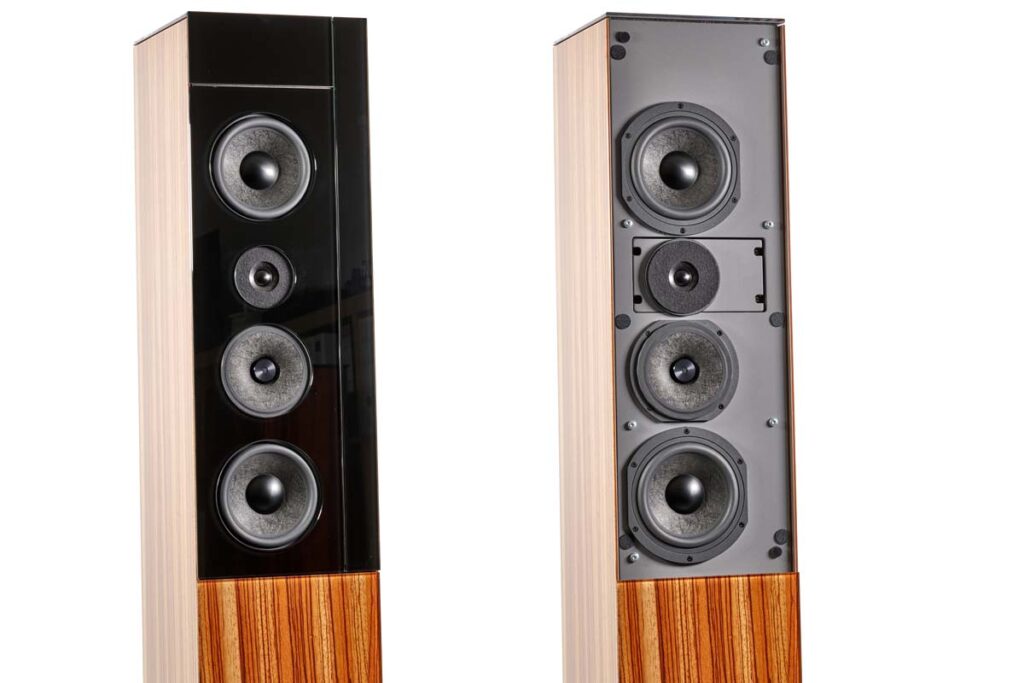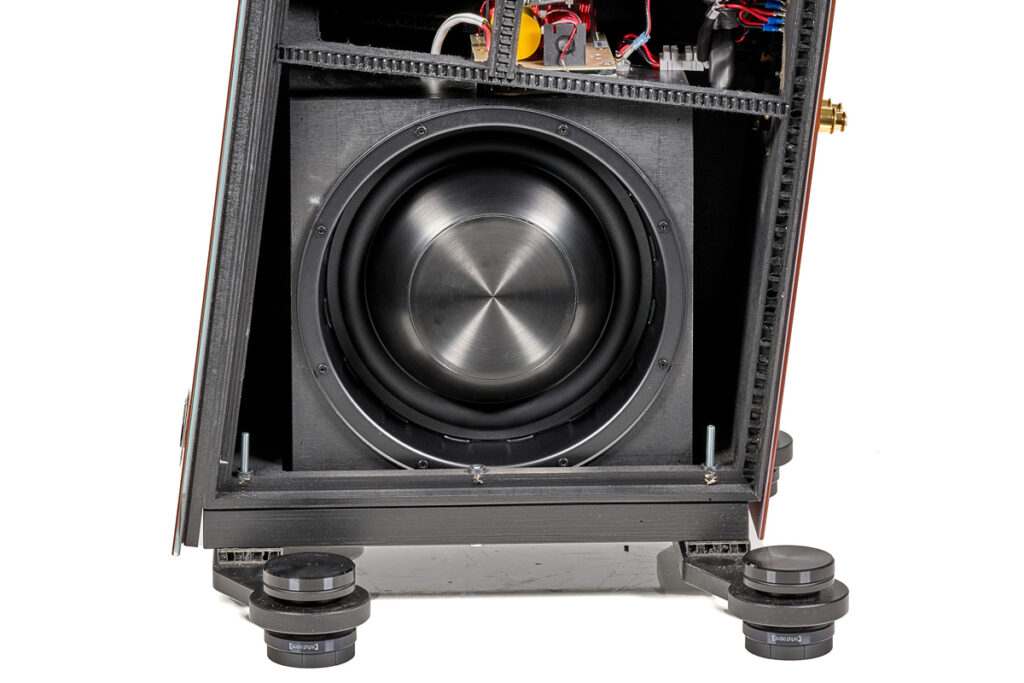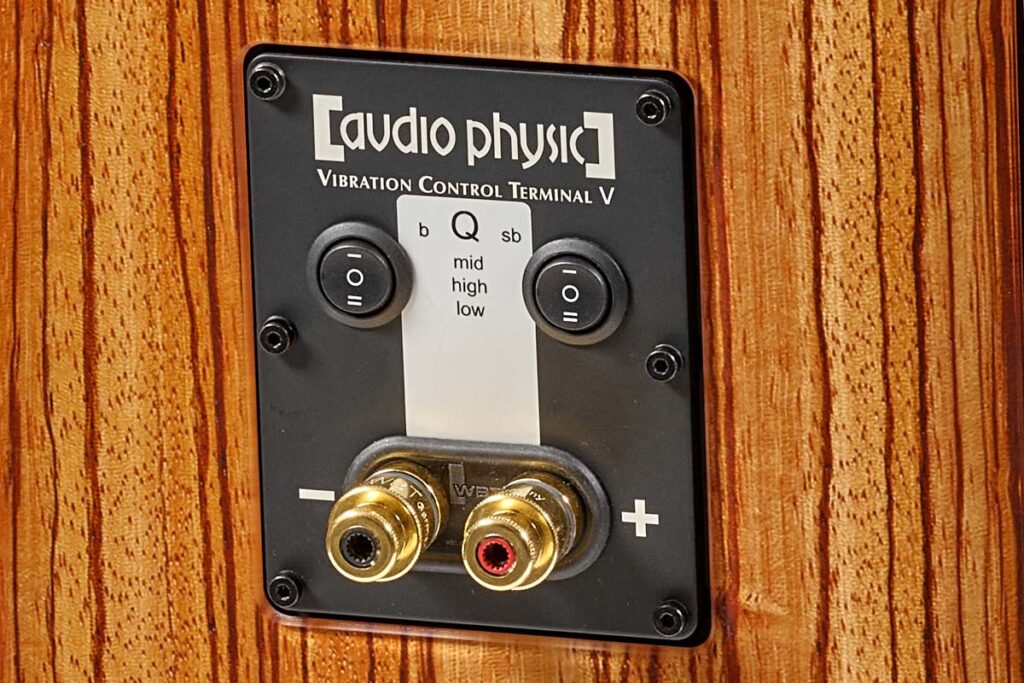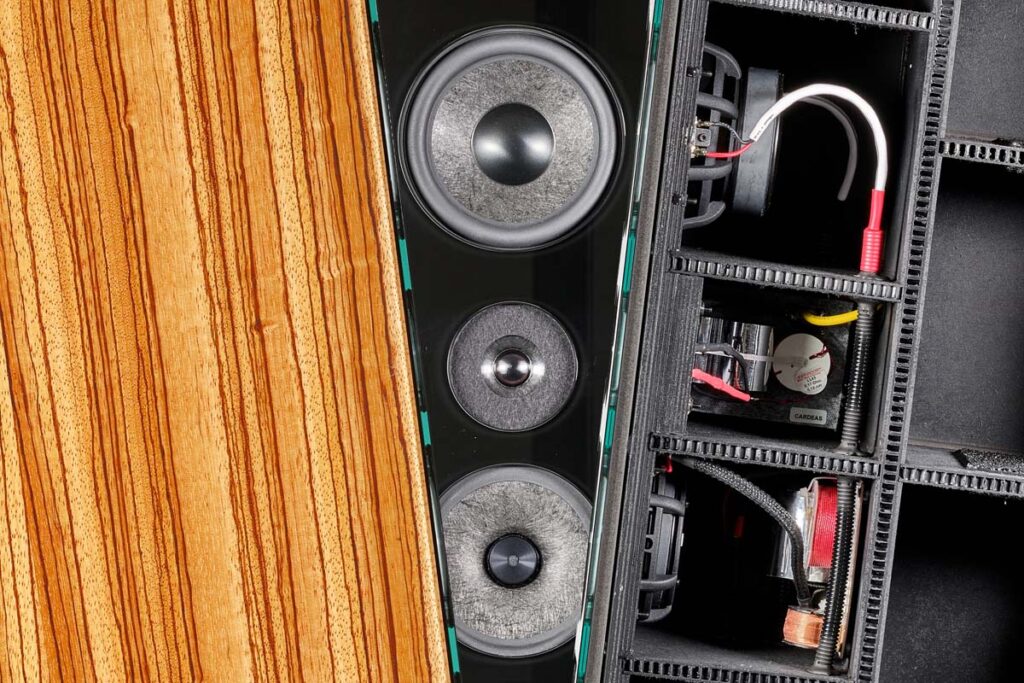To achieve the impossible, and in extreme environments no less, you have to think about ordinary things completely differently. The wheels on a Mars Rover are round, but they function completely differently than those on a Toyota Corolla. Manfred Diestertich just wants to listen to music in his living room, but he is constantly driven to reinvent the wheel at every turn – and with spectacular results.
The Audio Physic Cardeas 2.0 looks like a loudspeaker: tall, slim and angular, with drivers at the front. It also works like almost any other transducer – superficially speaking. No ribbons, AMTs or other exotic tweeter shapes. All of the drivers are of the usual dynamic variety. However, anyone who has ever been up close and personal with Manfred Diestertich’s creations knows that almost every component works differently than usual and for a good reason.
A glass housing, for example, doesn’t sound useful for a loudspeaker. However, it’s just an outer casing that is elastically coupled to the inner housing, which is made of a honeycomb MDF composite material. The purpose of this is to connect two materials with completely different resonance behavior. Therefore, the outer skin isn’t moved by any vibrations from the main body, thus making no sound at all. From the outside (and that’s how it should be) very little of this technical finesse is visible.
This theme of clever and invisible detailed solutions is threaded throughout the loudspeaker. Thus, Audio Physic had the foresight to send us a cut-away model in addition to the test pair. This was mainly for the photos, but it didn’t take long for a small crowd of curious editors’ noses to work their way through the half-open housing chambers. The most striking feature, and the largest, is the separate woofer housing located in the actual body, which we already know about from the outgoing Cardeas. From the rather small closed chamber, not one but two bass drivers work into the housing in a push-push arrangement. In turn, their movement impulses cancel each other out before they can be transmitted to the loudspeaker itself.
All of this is quite impressive, but why go through all that trouble with this “pressure chamber bass”. In conversation, Diestertich explains that it came down to not unnecessarily breaking open the beautiful glass case. Side-mounted bass drivers have a certain tradition at Audio Physic, because they allow the combination of ample membrane surface in the basement and a beautifully slim baffle. Furthermore, if you can make this membrane surface completely invisible, then all the better. Acoustically, the system behaves in essentially the same way as a conventional bass reflex enclosure, yet it has a hidden ace up its sleeve.
Experience has shown that downward-facing reflex channels are more forgiving when it comes to listening room placement. Usually this advantage partially cancels itself out because the bass then comes from two sources, one of which dominates at a time, depending on the frequency.
In addition, the two are often quite far apart and radiate in different directions.
Although the low frequency wavelengths are long, the speaker’s room reaction can become somewhat unpredictable. The bass of the Cardeas sequentially puts pressure on the housing and then the room. Therefore, there is only one bass source directed downwards, which can only be good for the coupling to the room acoustics.
The next thing we noticed were the dual voice coils on the upper bass and midbass drivers. They are connected to the attenuation switches on the connection terminals, which can be set separately in three positions for low and low-mid tones. Here Diestertich specifically exploits the eddy currents that are induced by the voice coil movement in the air gap, thus counteracting it. In other words, he dampens it. The switches can partially or completely remove the second coil from the signal path, thereby reducing the attenuation of the entire system. In the standard zero position, the coil is short-circuited and the loudspeaker works with a Q of around 0.6, so it is almost critically damped. In layman’s terms, this means you can expect the beautifully slim, fast and crisp bass that we are used to from Audio Physic.
If you like a lot of Eurythmics or certain old prog rock recordings (such as “YYZ” from Rush’s album Moving Pictures), where it can get thin and woody in the basement, then you can remove the attenuation in two stages to get a slightly fuller, rounder bass at the expense of some speed. And this works separately for low-midrange and bass, so you should have enough permutations available for the entire music collection. In this context, Diestertich is very proud of that fact that the Cardeas shows a fairly linear impedance curve regardless of the damping setting. Naturally the curve changes in the resonance area, but the impedance minimum never drops far below the nominal value in any position. In any scenario, the amplifier should see a nice, even load.
As compared to its predecessor, which we already reviewed in FIDELITY 54, most things have remained unchanged. The most significant change, as Diestertich emphasizes, is the membrane material, which replaces the previous aluminum in all of the drivers, from the bass-midrange speakers to the small tweeter cone. For Diestertich, metal membranes have always been the best compromise, but nonetheless a compromise. Hard membranes lack the natural physicality of paper, but their superior resolving power was the deciding factor for him. Like every aspect of his designs, Diestertich naturally questioned this: high-tech materials such as Kevlar or carbon fiber composites are everywhere. However, they could never completely convince him, because the synthetic resins that adjust the strength have undue resonances in conjunction with the regular material structure. And so he stuck with the old faithful aluminum. That is until he came across a new miracle formula that he hasn’t stopped raving about: a carbon fiber fabric embedded in a polypropylene matrix. Similar to the pulp fibers in paper, its carbon fibers are arranged chaotically, which naturally offers poor “working conditions” for resonances. This seems promising and, as listening tests soon showed, sounds excellent. Diestertich deems this nothing less than the “membrane material of the future”. And, for his ear, it combines the best of both worlds.
The Dead South soon help me find out what my ear says: “In Hell I’ll Be In Good Company” from their debut album Good Company offers a representative selection of natural sound events with two voices, banjo, guitar and cello, plus a whistled melody and finger snaps – excellent for getting a quick impression of the reproduction credibility.
As it turns out, the Cardeas hits the timbres precisely: whistles and finger snaps cut and click through the room pointedly and sharply, but always with the right substance. The cello strings burst out with their notes, which are immediately answered by the instrument’s warm, woody body hum, while Nathaniel Hilts’ croaky-brightness and Danny Kenyon’s sonorous-density alternately do the honors. All explosive elements burst into existence and fade away with captivating naturalness, while the lower registers spread out in the room, organic, warm. If the recording doesn’t need to be “saved” by sound make-up, the attenuation switches should clearly be in position “0”.

Especially when the beat is supposed to drive as beautifully as in “Destroy Everything You Touch” by Ladytron (Witching Hour) or “Technopolis” by Yellow Magic Orchestra (Solid State Survivor). The latter in particular demonstrates the enormous sharpness of separation in the countless shimmering sound effects. There is also a fascinating effortlessness with which the Cardeas conjures an extensive and well-organized stage in the room. For me, this is one of the distinguishing features of an Audio Physic par excellence.
Another piece comes to mind on the subject of separation: Charles-Valentin Alkans Étude WoO from the Encyclopédie du Pianiste Compositeur is a lightning-fast piano piece in which a surprisingly complex rhythm figure stretches between the left and right hands, forming an overarching melody.
Through the Cardeas, the structure of the playing is easily determined through the warm, full resonance of the piano body. At the same moment, I can literally see the left and right hands in front of me and understand at any moment how they share their work and complement one another in absolute coherence.
Is the Cardeas more on the warm and full side or on the tight and precise side? Clear answer: both! Musical sonority and razor-sharp precision don’t feel like a balancing act, rather the natural state, presented with casual self-evidence. I definitely feel that the sonic progress when compared to the predecessor can be clearly understood in a direct comparison. However, even more important to me is that it still sounds unmistakably like an Audio Physic.
Accompanying Equipment
CD players: Ayon CD-3sx, Audio Note CD 3.1x | Network players/Streamers: Lumin P1, T+A PSD 3100 HV | Preamplifiers: Accuphase C-2300, Soul Note P-3 | Integrated amplifiers: Line Magnetic LM-88IA, Aavik I-580 | Power amplifiers: Burmester 216, Riviera AFS-32, Soulnote M-3x | Loudspeakers: Wilson Audio Sasha DAW, Wilson Benesch Omnium | Racks: Solidsteel, Finite Elemente, beaudioful | Cables: AudioQuest, HMS, in-akustik, Vovox
Loudspeaker Audio Physic Cardeas 2.0
Concept: 4-way floorstanding speaker, passive | Driver complement: 2 x 28 cm woofers, 18 cm bass-midrange drivers, 15 cm mid-range drivers (HHCM V SL+, centerless), 39 mm tweeters (HHCT V+) | Terminal: Single-Wire with WBT PlasmaProtect and attenuation switch for low-mid and low frequencies | Frequency response: 25 Hz to 40 kHz | Impedance: 4 Ω | Sensitivity: 89 dB | Recommended amplifier power: 40 to 350 W | Special features: membranes made of carbon fiber fabric in PP matrix, midrange driver without centering spider, woofer in internal pressure chamber in push-push arrangement | Versions: glass white high gloss, glass black high gloss as well as glass red, anthracite, glass pearl white, glass silver/grey at an additional cost |Weight: 63kg | Dimensions (W/H/D): 25/128/43 cm | Warranty period: 5 years | Price: around € 38,990 (special colors around € 42,990)
Audio Physic
Almerfeldweg 38
59929 Brilon
Phone +49 2961 961 70
info@audiophysic.com


